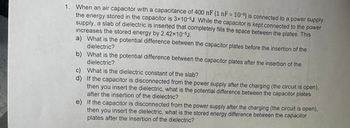
College Physics
11th Edition
ISBN: 9781305952300
Author: Raymond A. Serway, Chris Vuille
Publisher: Cengage Learning
expand_more
expand_more
format_list_bulleted
Concept explainers
Question

Transcribed Image Text:1. When an air capacitor with a capacitance of 400 nF (1 nF = 10-9) is connected to a power supply,
the energy stored in the capacitor is 3x10-5J. While the capacitor is kept connected to the power
supply, a slab of dielectric is inserted that completely fills the space between the plates. This
increases the stored energy by 2.42×10-5J.
a) What is the potential difference between the capacitor plates before the insertion of the
dielectric?
b) What is the potential difference between the capacitor plates after the insertion of the
dielectric?
c)
d)
What is the dielectric constant of the slab?
If the capacitor is disconnected from the power supply after the charging (the circuit is open),
then you insert the dielectric, what is the potential difference between the capacitor plates
after the insertion of the dielectric?
e) If the capacitor is disconnected from the power supply after the charging (the circuit is open),
then you insert the dielectric, what is the stored energy difference between the capacitor
plates after the insertion of the dielectric?
Expert Solution
This question has been solved!
Explore an expertly crafted, step-by-step solution for a thorough understanding of key concepts.
Step by stepSolved in 3 steps with 2 images

Knowledge Booster
Learn more about
Need a deep-dive on the concept behind this application? Look no further. Learn more about this topic, physics and related others by exploring similar questions and additional content below.Similar questions
- 1. An air-filled capacitor is made from two flat parallel plates 1.5 mm apart. The inside area of each plate is 7.9 cm². (a) What is the capacitance of this set of plates? F Cair = (b) If the region between the plates is filled with a material whose dielectric constant is 6, what is the new capacitance? C dielectric = Farrow_forward11. A rectangular parallel plate capacitor (length = L and width= 2L) contains a dielectric with a constant k₁. A square parallel plate capacitor (whose length and width are both L and is filled with a material whose dielectric constant is 4k₁) has the same capacitance as the rectangular one just described. How thick (d) is the square capacitor (ds) compared to the rectangular capacitor (d,)? A. ds = 2d, B. d₂ = d, C. d = 4d, D. ds = 8drarrow_forwardCharge q is fired through a small hole in the positive plate of a capacitor, as shown.a. If q is a positive charge, does it speed up or slow down inside the capacitor? Answer this question twice: (i) Using the concept of force. (ii) Using the concept of energy.b. Repeat part a if q is a negative charge.arrow_forward
arrow_back_ios
arrow_forward_ios
Recommended textbooks for you
 College PhysicsPhysicsISBN:9781305952300Author:Raymond A. Serway, Chris VuillePublisher:Cengage Learning
College PhysicsPhysicsISBN:9781305952300Author:Raymond A. Serway, Chris VuillePublisher:Cengage Learning University Physics (14th Edition)PhysicsISBN:9780133969290Author:Hugh D. Young, Roger A. FreedmanPublisher:PEARSON
University Physics (14th Edition)PhysicsISBN:9780133969290Author:Hugh D. Young, Roger A. FreedmanPublisher:PEARSON Introduction To Quantum MechanicsPhysicsISBN:9781107189638Author:Griffiths, David J., Schroeter, Darrell F.Publisher:Cambridge University Press
Introduction To Quantum MechanicsPhysicsISBN:9781107189638Author:Griffiths, David J., Schroeter, Darrell F.Publisher:Cambridge University Press Physics for Scientists and EngineersPhysicsISBN:9781337553278Author:Raymond A. Serway, John W. JewettPublisher:Cengage Learning
Physics for Scientists and EngineersPhysicsISBN:9781337553278Author:Raymond A. Serway, John W. JewettPublisher:Cengage Learning Lecture- Tutorials for Introductory AstronomyPhysicsISBN:9780321820464Author:Edward E. Prather, Tim P. Slater, Jeff P. Adams, Gina BrissendenPublisher:Addison-Wesley
Lecture- Tutorials for Introductory AstronomyPhysicsISBN:9780321820464Author:Edward E. Prather, Tim P. Slater, Jeff P. Adams, Gina BrissendenPublisher:Addison-Wesley College Physics: A Strategic Approach (4th Editio...PhysicsISBN:9780134609034Author:Randall D. Knight (Professor Emeritus), Brian Jones, Stuart FieldPublisher:PEARSON
College Physics: A Strategic Approach (4th Editio...PhysicsISBN:9780134609034Author:Randall D. Knight (Professor Emeritus), Brian Jones, Stuart FieldPublisher:PEARSON

College Physics
Physics
ISBN:9781305952300
Author:Raymond A. Serway, Chris Vuille
Publisher:Cengage Learning

University Physics (14th Edition)
Physics
ISBN:9780133969290
Author:Hugh D. Young, Roger A. Freedman
Publisher:PEARSON

Introduction To Quantum Mechanics
Physics
ISBN:9781107189638
Author:Griffiths, David J., Schroeter, Darrell F.
Publisher:Cambridge University Press

Physics for Scientists and Engineers
Physics
ISBN:9781337553278
Author:Raymond A. Serway, John W. Jewett
Publisher:Cengage Learning

Lecture- Tutorials for Introductory Astronomy
Physics
ISBN:9780321820464
Author:Edward E. Prather, Tim P. Slater, Jeff P. Adams, Gina Brissenden
Publisher:Addison-Wesley

College Physics: A Strategic Approach (4th Editio...
Physics
ISBN:9780134609034
Author:Randall D. Knight (Professor Emeritus), Brian Jones, Stuart Field
Publisher:PEARSON